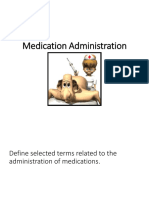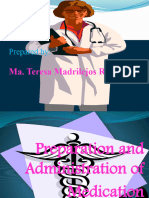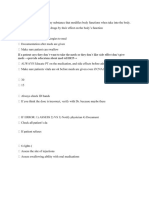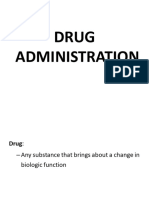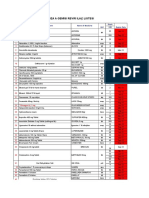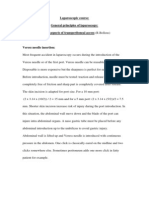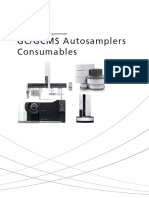0 ratings0% found this document useful (0 votes)
11 viewsFunda. Rle
Uploaded by
yassermacacunapundugar08092002Copyright
© © All Rights Reserved
Available Formats
Download as PDF, TXT or read online on Scribd
0 ratings0% found this document useful (0 votes)
11 viewsFunda. Rle
Uploaded by
yassermacacunapundugar08092002Copyright
© © All Rights Reserved
Available Formats
Download as PDF, TXT or read online on Scribd
You are on page 1/ 4
HEALTH ASSESSMENT LECTURE 4.
Brand Name / Trademark Name
- assigned name for a certain drug when the pharmaceutical
companies market the drug.
Medication Administration
▪ is a basic nursing function that involves skillful technique EFFECTS OF DRUGS
and consideration of the patient's development & safety. a. Therapeutic Effect / Desired Effect
▪ The nurse who is administering the medication needs - is the primary effect intended for the prescribed drug.
knowledge about drugs, which includes drug name, b. Side Effect / Adverse Effect
preparation, classification, adverse effect, and physiologic - is the secondary effect of a drug
factors that affect drug action. - Unintended
- Usually predictable and maybe either harmless or
Purpose of medication potentially harmful
Drugs can be administered for these purposes: c. Drug Toxicity
• Diagnostic purpose: to identify any disease - Deleterious effect of a drug to an
• Prophylaxis: to prevent the occurrence of disease. eg.- heparin - Regarrison over dosage, ingestion of a drug intended
to prevent thrombosis or antibiotics to prevent infection. for external use, or cumulative effect of a drug
• Therapeutic purpose: to cure the disease. d. Drug Allergy - is an immunologic reaction to a drug
Uses of Drugs 2. Pruritus - itching of the skin with or without rash
1. Prevention- used as prophylaxis to prevent diseases (accompanies most rashes)
e.g. vaccines; fluoride prevents tooth decay. 3. Angioedema - edema due to increased permeability of the
2. Diagnosis - establishing the patient's disease or blood capillaries.
problem e.g. radio contrast dye; tuberculosis (Mantoux) 4. Rhinitis - Inflammation of mucous
testing. membranes lining the nose; causes swelling and clear, watery
3. Suppression- suppresses the signs and symptoms and discharge (excessive watery discharge from the nose).
prevents the disease process from progressing e.g. 5. Lacrimal Tearing – excessive tearing
anticancer, antiviral drugs. 6. Nausea / Vomiting
4. Treatment- alleviate the symptoms for patients with 7. Wheezing - due to accumulated fluids and swelling of the
chronic disease e.g. Anti-asthmatic drugs. respiratory tissue.
5. Cure- complete eradication of diseases e.g. anti-biotics, 8.Dyspnea - difficulty of breathing
anti-helminthics. 9. Diarrhea - irritation of the large mucosa o1
6. Enhancement aspects of health- achieve the best state the intestine.
of health e.g. vitamins, minerals.
Anaphylactic Reaction
DRUG STANDARDS- developed to ensure uniform quality A severe allergic reaction usually occurs immediately after the
of drugs. administration of the drug.
R.A. 6425 - Dangerous Drugs Act, states that sale,
administration, delivery, distribution, and transportation of Drug Tolerance
prohibited drugs are punishable. Exists in a person who has unusually low physiologic response
to a drug and who require an increase in the dosage to maintain
The written direction for the preparation and administration of a a given therapeutic effect.
drug is called a prescription.
PRINCIPLES OF MEDICATION ADMINISTRATION
DRUG NOMENCLATURE • NO medication may be given to a patient without medication
1. Chemical Name order from the physician.
- is a precise description of a drug's chemical composition
2. Generic Name Types of Medication Order:
- is the name assigned by the manufacturer who first develop 1. Stat Order- Ex. Demerol 100mg. IM @ once
the drug 2. Single Order - Ex. Seconal 100mg. HS before surger
3. Official Name 3. Standing Order- Ex. Demerol 100mg. IM q4h X 5 days
- is the name by which the drug is identified on the official 4. PRN Order - Ex. Dolfenal 500mg. PRN
publication
Parts of Medication Order: 7. Right to Refuse Medication
1. The name of the client The patient has the right to refuse any medication. However, the
2. The date and time when the order was nurse is obliged to explain to patients why the drug is prescribed
3.Widerrame of the drug to be administered and the consequences refusing medication.
4. The dosage of the drug
5. The route and special directives of administration 8. Right Assessment
6. The time and frequency of administration Some medications require specific assessment before their
7. The signature of the person writing the order administration e.g. checking of vital signs. Before a medication
like Digoxin is administered the pulse must be checked.
NURSING MANAGEMENT Some medication orders may contain specific assessments to
- Give medication to patient. be done prior to medication.
- Check patient's identification.
- check the label of the drug before removing in the box 9. Right Documentation
(Carefully read labels) Documentation should be done after medication and not before.
- Check the color and order (Double-check with
pharmacist about dose range) 10. Right Evaluation
- Check the expiration dates on the medication labels Conduct assessment to ascertain drug action, both desired an
Have a colleague double check dosage calculation. side effect.
- Clarify orders that are incomplete contains
abbreviations is.confusing on hard to read or raises a 11.RIGHTT APPROACH
question. Always introduced yourself to the patient first and explain the
procedure to them. It is important to maintain privacy to ensure
RIGHTS IN DRUG ADMINISTRATION patient comfort.
1. Right Drug 12. RIGHT PRESCRIPTION
Before administering any medication, it is imperative to Right to have eligible orders, correct drug dispensing
compare the exact spelling and concentration of the prescribed
drug with the medication card or drug profile and the medication 13. RIGHT CLINICIAN
container. Nurse's display of clinical and pharmacological knowledge,
› Nurse should: clinical experience, and the ability to perform comprehensive,
a. Check the label when removing the drug container from the situational assessments of the patient medication
client's medication drawer administration.
b. Check the drug when removing from the container
c. Check the drug before returning it to the client's medication 14. RIGHT PRINCIPLE OF CARE
drawer. Decision - making regarding care and treatments to be a shared
responsibility.
2. Right Dose
The nurse must correctly calculate the dosage and have it PREPARATION AND ROUTE
double checked before administering. 1. Oral Route
▪ Safest, most convenient, and least expensive
3. Right Client ▪ Disadvantage: slower action, unpleasant taste, and
The nurse must properly identify the client before administration. irritation of the gastric mucosa
▪ Drugs taken by mouth have slower onset but a more
4. Right Route prolonged effect.
The route of a medication is specified in the written order e.g. 2. Buccal, sublingual, and translingual
oral, IM, IV,ID,SQ ▪ Certain drugs, such as Nitroglycerin, are given through
these routes to prevent their destruction or
6. Right to information on drug/client education transformation in the stomach or small intestine.
The patient has the right to know the drug he/she is taking, ▪ Buccal - given in the pouch between the cheek and
desired and adverse effects and all there is to know about the teeth.
medication. The charter on patient's right made this clear. ▪ Sublingual - under the tongue
▪ Translingual - on the tongue
3. Gastric Route
▪ It allows direct administration of a drug into the Gl B. SUBCUTANEOUS
system. This route is used when patients can't ingest Small amounts of a drug are injected beneath the dermis and
the drug orally. into the subcutaneous tissue, usually in vascular areas like: the
4. Respiratory patient's upper arm (outer aspect), scapular areas of the upper
▪ Drugs that are available as gases can be administered back, upper abdomen from below the costal margins to the iliac
into the respiratory system through inhalation. These crests, or anterior aspect of the thighs.
drugs are rapidly absorbed. This allows the drug to move into the bloodstream more rapidly
5. Parenteral Route than if given by mouth.
- injection Drugs given subcutaneously include non-irritating aqueous
- Has the fastest action solutions and suspensions contained in 0.5 to 2 ml of fluid, such
as heparin and insulin.
Administration of Oral Drugs Needle 25-23 gauge : 1 inch
▪ Client should be in a sitting or side-lying position. Inject needle quickly and firmly at 45 degree angle
▪ Be sure to compare medicine card with doctor's order, No site should be used for more than 6-7 weeks
the drug itself and the patient before administering.
▪ Discard drug which has fallen onto the floor. C. INTRAMUSCULAR (IM) - injection into the muscle
▪ Stay with client until the medication has been • The route allows drugs to be injected directly into
swallowed. various muscle groups at varying tissue depths
▪ For highly acidic medications like aspirin, offer a non- • This form of administration provides rapid systemic
fat snack like crackers. action and allows for absorption of relatively large
doses (up to 5 ml).
PARENTERAL ROUTE • Aqueous suspensions and solutions in oil as well as
▪ A syringe is used when drugs need to be administered drugs that aren't available in oral forms are given I.M.
through a vein or muscle. • 18-23 gauge: 1-2 inches needle
▪ The syringe consists of a needle attached to a hollow • Inject needle quickly at 90 degree angle into the
cylinder that is marked with precise measurements so muscle, e.g., antibiotics
that the exact amount of medication can be given.
• If medication is irritating, e.g., iron preparation, the Z-
track technique is used since it minimizes tissue
Administration of Injectable Drugs
irritation by sealing the drug within the muscle tissues
Prevent Infection
▪ Withdraw medication from ampule quickly. Do not
SITES IF INTRAMUSCULAR INJECTIONS
allow it to stand open to prevent contamination of
1. Vastus Lateralis
solution.
• located on the anterolateral aspect of the thigh.
▪ Avoid touching length of plunger or inner barrel. Keep
• it is preferred injection site for children and infants
tip of syringe always covered.
(from birth until before 7 months old)
▪ If given frequently, rotate sites not only to prevent
• the middle third of the muscle is the best site for
infection but also to optimize absorption
injection e.g. vit k, Hepa B vaccine
• rapid drug absorption occurs
4 Parenteral Routes: • No major blood vessels or nerves.
A. INTRADERMAL (ID)
2. Deltoid
▪ Drugs are injected into the skin (dermis)
• not used in infants and children because it is not
▪ A needle is inserted at a 10 to 15 degree angle so that
well developed, and nerves and arteries lie within.
it punctures only the skin's surfaces.
▪ It is used mainly for diagnostic purposes, such as
3. Ventrogluteal muscle
testing for allergies or tuberculosis.
• involves the gluteus medius and minimus.
▪ Needle: 25 gauge: 1 inch
• The nurse locates the muscle by placing the heel of
▪ Needle is almost against client's skin, inserting it slowly
the hand over the greater trochanter of the client's hip.
until resistance is felt.
▪ DO NOT massage • The nurse points the thumb toward the head, places
the index finger over the anterior superior iliac spine
• and extends the middle finger back along the iliac • Client should remain on side-lying position for 2-3 minutes
crest toward the buttocks. after instillation.
• The index finger, middle finger, and iliac crest form a • Gentle pressure or massage is applied to the ear with a
V-shaped triangle; the center of the triangle is the finger
injection site.
e. Nasal Instillations
4. Dorsogluteal muscle (Upper outer Butt) • By spray, drops or tampons
• a traditional site for IM injections in adults, it is located in • Most common is decongestant spray to relieve
the upper outer aspect of the upper outer quadrant of the symptoms of sinus congestion and colds
buttock, approximately 5-8 cm (2-3 in.) below the iliac crest. • Clients must be cautioned against overuse because it
can lead to a rebound effect
D. INTRAVENOUS (IV) - injection into the vein
• The route allows injection of drugs and other substances
directly into the bloodstream through a vein.
• Appropriate substances to administer I.V. include drugs,
fluids, blood or blood products, and diagnostic contrast
agents.
• Administration can range from a single dose to an ongoing
infusion that's delivered with great precision.
• Large value infusions - D5W or NSS or D5.3 NSS
• IM bolus - introduction of a concentrated dose of a drug
directly into systemic circulation e.g. D50 -50 # 50 ml,
Sodium Bicarbonat e# 20 ml
• Used during emergencies, with critically unstable clients
and as a route of administration when rapid and predictable
responses are required
• May be given directly into a vein, into an existing IV line or
through a heparin block.
• The most dangerous method for administering drugs
because there is no time to correct errors and can cause
irritation to the blood vessels.
• Plesyback IV administration - small (50 or 100 ml) IV
bags or bottle connected to a short tubing line that connects
to the upper Y-port of a primary infusion line or an
intermittent venous access. The piggyback tubing is a
micro- or macro-drip system.
6. Topical Route
Large number of topical drugs are applied to the skin, but others
include eye, nose, throat, ear, rectal, and vaginal preparations.
c. Ear Instillations
• Drug instilled should be at room temperature, otherwise will
cause vertigo or nausea
• Client should be on side-lying position with the affected ear
up
• Straighten ear canal by pulling earlobe down and back (in
children) or upward and outward (in adults)
• Drug is instilled by holding dropper 1 cm above ear canal
You might also like
- Pharmacoepidemiology, Pharmacoeconomics,PharmacovigilanceFrom EverandPharmacoepidemiology, Pharmacoeconomics,Pharmacovigilance3/5 (1)
- Admintrationofmedications1 Copy 181202173921No ratings yetAdmintrationofmedications1 Copy 181202173921186 pages
- Admintrationofmedications1 Copy 181202173921No ratings yetAdmintrationofmedications1 Copy 181202173921186 pages
- The Regimen That Determines The Size, Frequency, and Number of Does of A Therapeutic Agent To Be Administered To A PatientNo ratings yetThe Regimen That Determines The Size, Frequency, and Number of Does of A Therapeutic Agent To Be Administered To A Patient4 pages
- Principles of Medication AdministrationNo ratings yetPrinciples of Medication Administration40 pages
- Medication Administration (Procedure 4) (1)No ratings yetMedication Administration (Procedure 4) (1)95 pages
- Role of Nurses in Drug Administration and Preventing Medication Errors100% (2)Role of Nurses in Drug Administration and Preventing Medication Errors35 pages
- Lecture #1 - NUR212 Medicationss & PharmacologyNo ratings yetLecture #1 - NUR212 Medicationss & Pharmacology14 pages
- Medications: Prepared By: Aleli R. Cheng, RN, MANNo ratings yetMedications: Prepared By: Aleli R. Cheng, RN, MAN128 pages
- Pharmacology Notes (Introduction To Pharmacology)No ratings yetPharmacology Notes (Introduction To Pharmacology)16 pages
- Attorney General V Mulenga (Appeal 68 of 2010) 2014 ZMSC 145 (20 November 2014)No ratings yetAttorney General V Mulenga (Appeal 68 of 2010) 2014 ZMSC 145 (20 November 2014)25 pages
- A Short Bevel Needle With A Very Thin TipNo ratings yetA Short Bevel Needle With A Very Thin Tip8 pages
- TCHP-Docetaxel Carboplatin Trastuzumab Pertuzumab Neoadjuvant Adjuvant Protocol V2.2No ratings yetTCHP-Docetaxel Carboplatin Trastuzumab Pertuzumab Neoadjuvant Adjuvant Protocol V2.221 pages
- Laparoscopic Course: General Principles of Laparoscopy: Specific Aspects of Transperitoneal Access (R.Bollens)No ratings yetLaparoscopic Course: General Principles of Laparoscopy: Specific Aspects of Transperitoneal Access (R.Bollens)4 pages
- Advances in Dental Local Anesthesia Techniques and Devices: An UpdateNo ratings yetAdvances in Dental Local Anesthesia Techniques and Devices: An Update6 pages
- GC GCMS Brochure - Autosamplers Consumables CatalogueNo ratings yetGC GCMS Brochure - Autosamplers Consumables Catalogue22 pages
- (180649) Methods of Drug AdministrationNo ratings yet(180649) Methods of Drug Administration13 pages
- NCERT Book Class 9 English Beehive Chapter 9 The Bond of LoveNo ratings yetNCERT Book Class 9 English Beehive Chapter 9 The Bond of Love14 pages
- Guidance To The International Medical Guides For Ships 3rd EditionNo ratings yetGuidance To The International Medical Guides For Ships 3rd Edition13 pages
- Giving Safe Injections: A Guide For Nurses and Others Who Give InjectionsNo ratings yetGiving Safe Injections: A Guide For Nurses and Others Who Give Injections43 pages
- Pharmacoepidemiology, Pharmacoeconomics,PharmacovigilanceFrom EverandPharmacoepidemiology, Pharmacoeconomics,Pharmacovigilance
- The Regimen That Determines The Size, Frequency, and Number of Does of A Therapeutic Agent To Be Administered To A PatientThe Regimen That Determines The Size, Frequency, and Number of Does of A Therapeutic Agent To Be Administered To A Patient
- Role of Nurses in Drug Administration and Preventing Medication ErrorsRole of Nurses in Drug Administration and Preventing Medication Errors
- Medication Education: Thinking Outside the Medicine CabinetFrom EverandMedication Education: Thinking Outside the Medicine Cabinet
- Everyday Pharmacology: How Drugs Affect Your Body and MindFrom EverandEveryday Pharmacology: How Drugs Affect Your Body and Mind
- Attorney General V Mulenga (Appeal 68 of 2010) 2014 ZMSC 145 (20 November 2014)Attorney General V Mulenga (Appeal 68 of 2010) 2014 ZMSC 145 (20 November 2014)
- TCHP-Docetaxel Carboplatin Trastuzumab Pertuzumab Neoadjuvant Adjuvant Protocol V2.2TCHP-Docetaxel Carboplatin Trastuzumab Pertuzumab Neoadjuvant Adjuvant Protocol V2.2
- Laparoscopic Course: General Principles of Laparoscopy: Specific Aspects of Transperitoneal Access (R.Bollens)Laparoscopic Course: General Principles of Laparoscopy: Specific Aspects of Transperitoneal Access (R.Bollens)
- Advances in Dental Local Anesthesia Techniques and Devices: An UpdateAdvances in Dental Local Anesthesia Techniques and Devices: An Update
- GC GCMS Brochure - Autosamplers Consumables CatalogueGC GCMS Brochure - Autosamplers Consumables Catalogue
- NCERT Book Class 9 English Beehive Chapter 9 The Bond of LoveNCERT Book Class 9 English Beehive Chapter 9 The Bond of Love
- Guidance To The International Medical Guides For Ships 3rd EditionGuidance To The International Medical Guides For Ships 3rd Edition
- Giving Safe Injections: A Guide For Nurses and Others Who Give InjectionsGiving Safe Injections: A Guide For Nurses and Others Who Give Injections



















